13 min to read
Unlocking Infinite Knowledge With ChatGPT
Harnessing ChatGPT for Evidence-Backed Learning Without Limits

Some folks are getting a bit spooked by an impending AI takeover, thinking think that the democratisation of artificial intelligence is going to eliminate jobs, become a threat to humanity, and is the first step towards the singularity. Although our future remains unwritten, I want to make it clear that I pledge my allegiance to our robot overlords.
In the meantime, let’s keep it real: AI is like the ultimate sidekick to knowledge workers. It’s all about making our lives easier and helping us dive into the sea of information on the internet without drowning. With the right know-how, ChatGPT can be like having a super-smart study buddy who can help you learn about anything you want.
As the internet’s ubiquity has made information readily accessible, AI tools, such as ChatGPT, have emerged as the adept curators of this knowledge. They excel at structuring, summarizing, and facilitating the comprehension of complex information.
In this blog post, I will show you how to harness the power of ChatGPT and leverage some ninja-level learning techniques to effectively and efficiently learn the required material for the Microsoft AZ-500 - Microsoft Security Technologies exam. But hey, don’t stop there – this same process can be applied to any subject matter that you want to learn.
The Pareto Principal
The Pareto Principal can be applied to learning a subject if you consider that 20% of the topics will typically cover 80% of the practical applications within that subject.
Now, let’s take the AZ-500 exam as an example. Hypothetically, let’s assume that this exam consists of just ten topics. According to the Pareto Principle, your best bet for an efficient study strategy would be to dedicate the majority of your time and effort to two out of those ten topics. Why? Because, in this scenario, these two topics would likely account for about 80% of the practical content you need to pass the exam.
In essence, the Pareto Principle guides us to optimize our learning by prioritizing the most crucial areas of a subject. By concentrating our efforts on the select few topics that hold the key to 80% of the practical knowledge needed, we can work smarter, not harder, to excel in our studies.
Using ChatGPT, we can figure out which of the topics (the 20%) you should focus on.
I want to learn how to study for the Azure AZ-500 exam. Use the Pareto Principal to identify which topics of the exam material to focus on
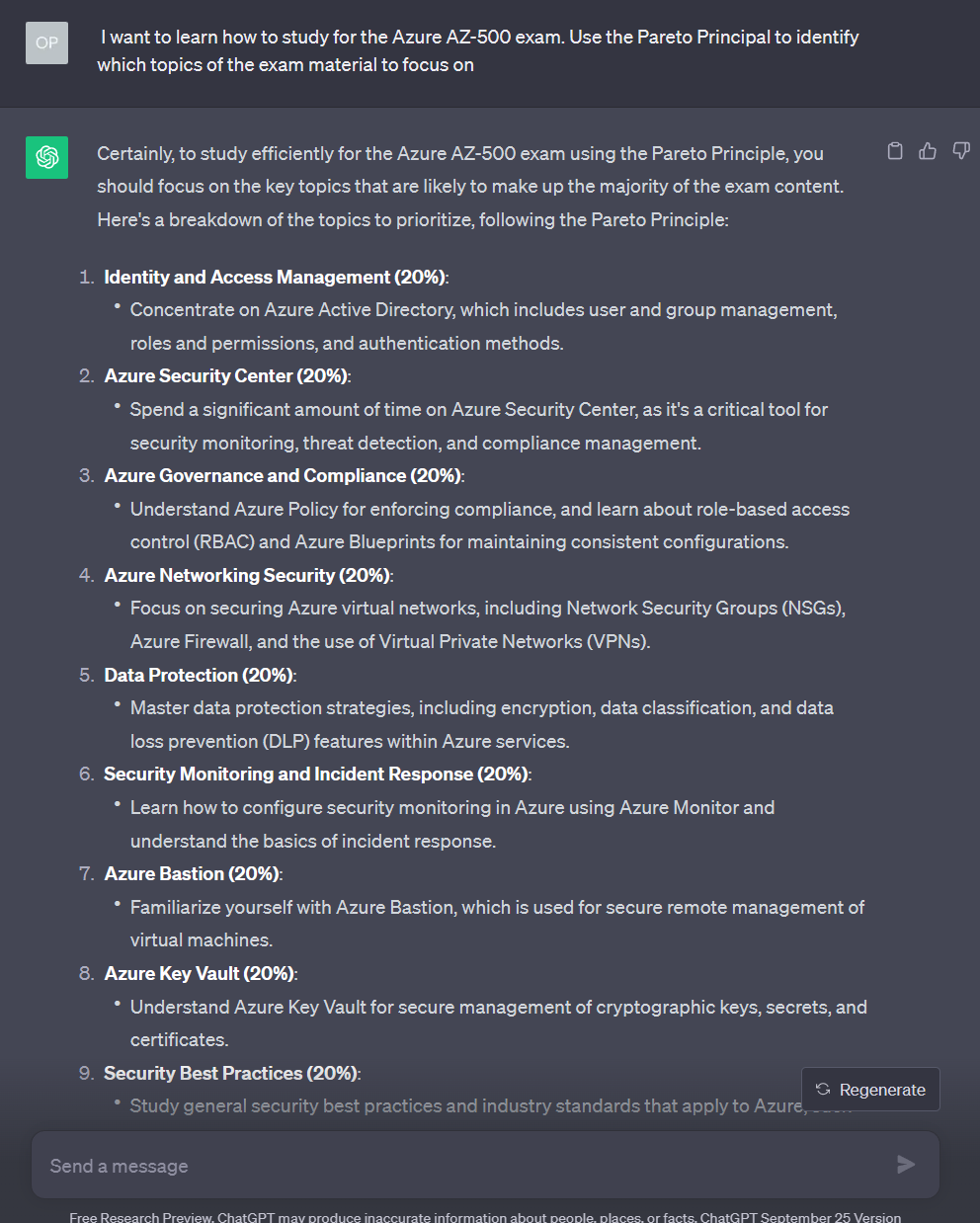
Create A Study Schedule
Now that you know what you need to learn, the next step is to create a study schedule. And guess what? ChatGPT can help with that too (are you starting to sense a theme here?).
Create a study schedule for the above in an appropriate amount of weeks. I can study on Monday and Wednesday between 6am and 8am, and Tuesday and Thursday between 7:30pm and 10pm. Include time for revision and testing.
ChatGPT will spit out a schedule so you can start immediately.
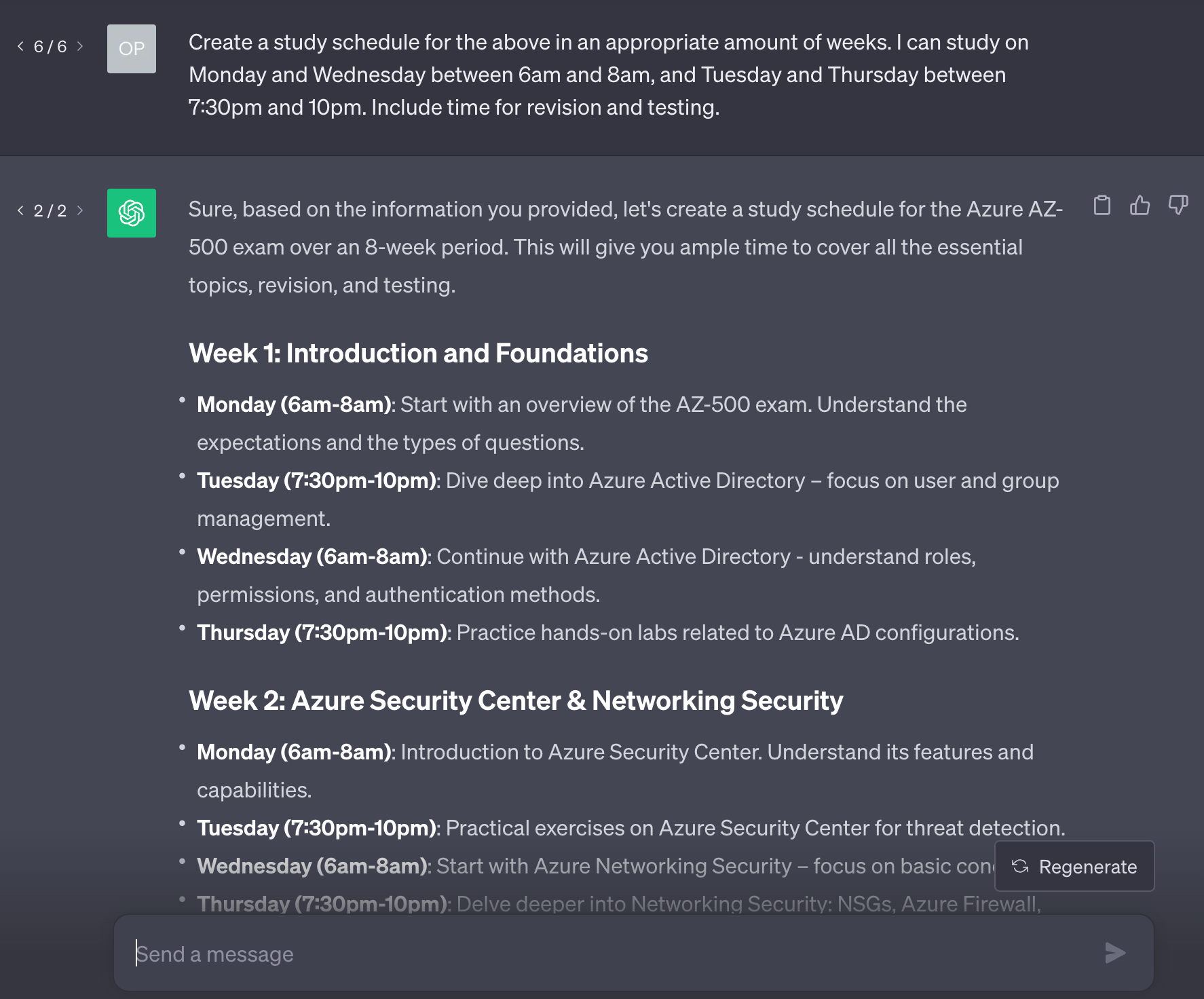
Generate Learning Resources
With a clear understanding of what to learn and a well-structured schedule in place, the final piece of the puzzle is the “how.” Now, you can tap into ChatGPT to provide you with the resources and materials you need to dive into all those subjects it recommended.
Suggest various learning resources (like books, videos, podcasts, interactive exercises, documentation) for the above topics that cater to different learning styles. Provide links to these resources
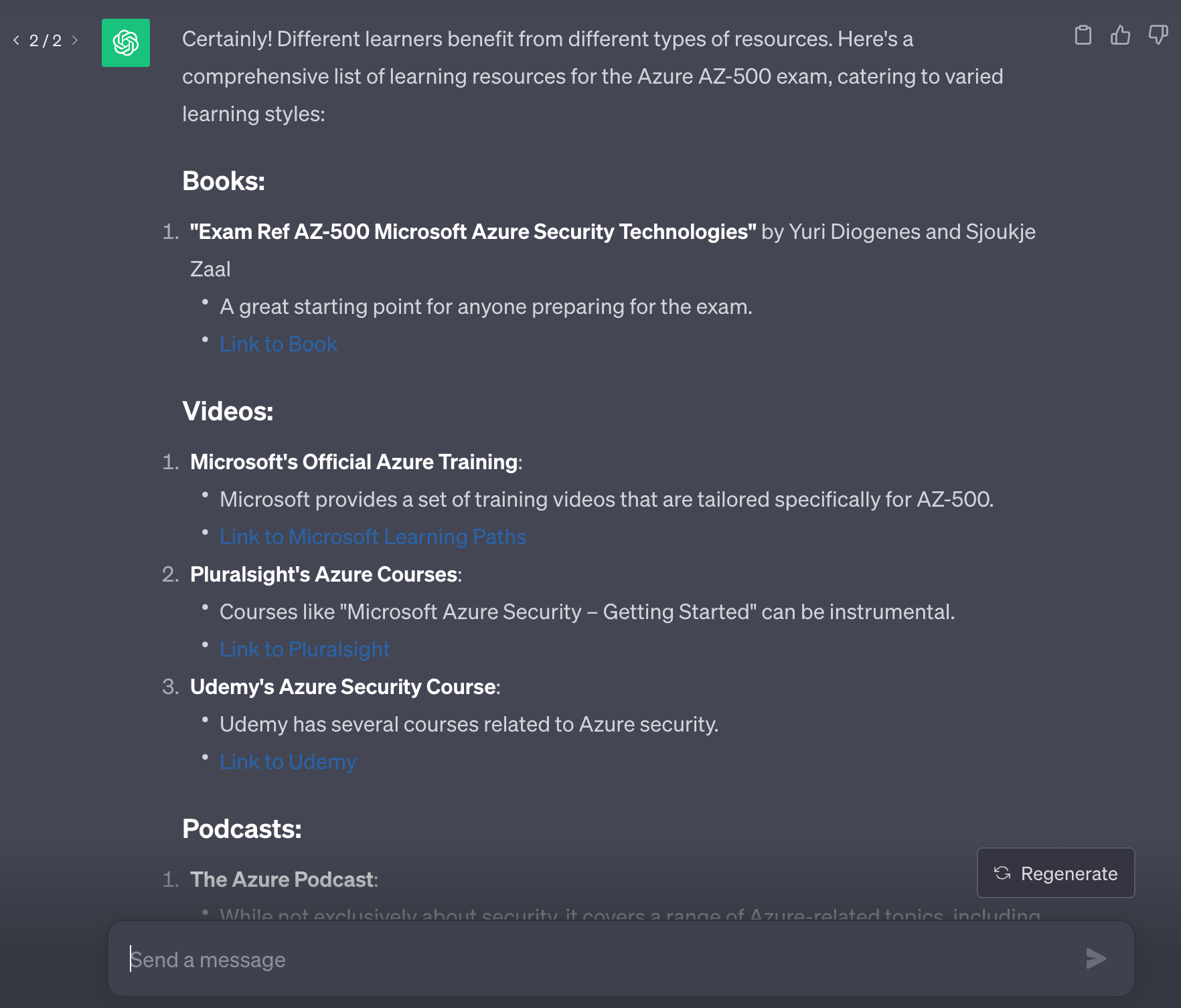
The beauty of this is not just the time it saves you from the wild goose chase of resource hunting. It’s all about the adaptability it brings to the table. You hold the reins here. Want only free resources? Easy. Prefer your materials in a visual format? Just ask. It’s like having a dedicated tutor by your side, crafting a learning experience tailored just for you.
Learn With Your Hands
Tell me and I forget. Teach me and I remember. Involve me and I learn. Benjamin Franklin
“Learn by doing” is a saying that resonates with my learning style. While reading books and documentation has it place, there’s something powerful about getting hands-on.
Using ChatGPT to generate project ideas are a fantastic way to solidify knowledge by learning with your hands.
Give me some beginner project ideas that I can create in Azure that cover the exam subject matter. Give me multiple project ideas. Not every project needs to cover every topic, but all topics should be covered over the multiple projects. For each project, give me a brief description and a desired outcome that can be tested, including steps to test whether I was successful or not.
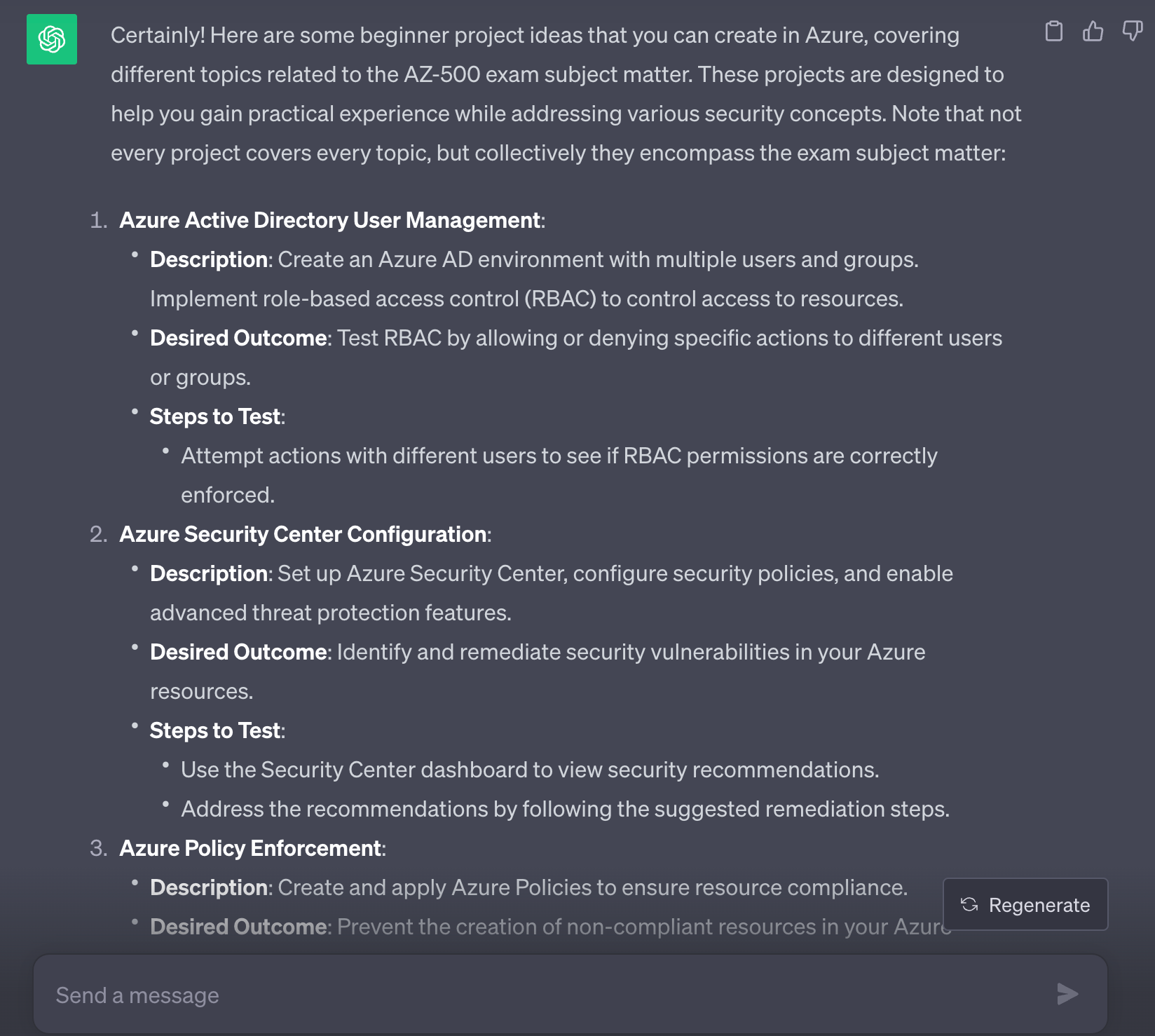
The Feynman Technique
As you dive into a subject, you’re bound to encounter obstacles – moments when you’re not sure how to do something or when a concept doesn’t seem to make any sense.
Using ChatGPT in combination of the Feynman Technique is a good way to get clarification on topics you feel like you don’t understand.
Using the Feynman technique, explain Azure security best practices to me in the simplest terms possible
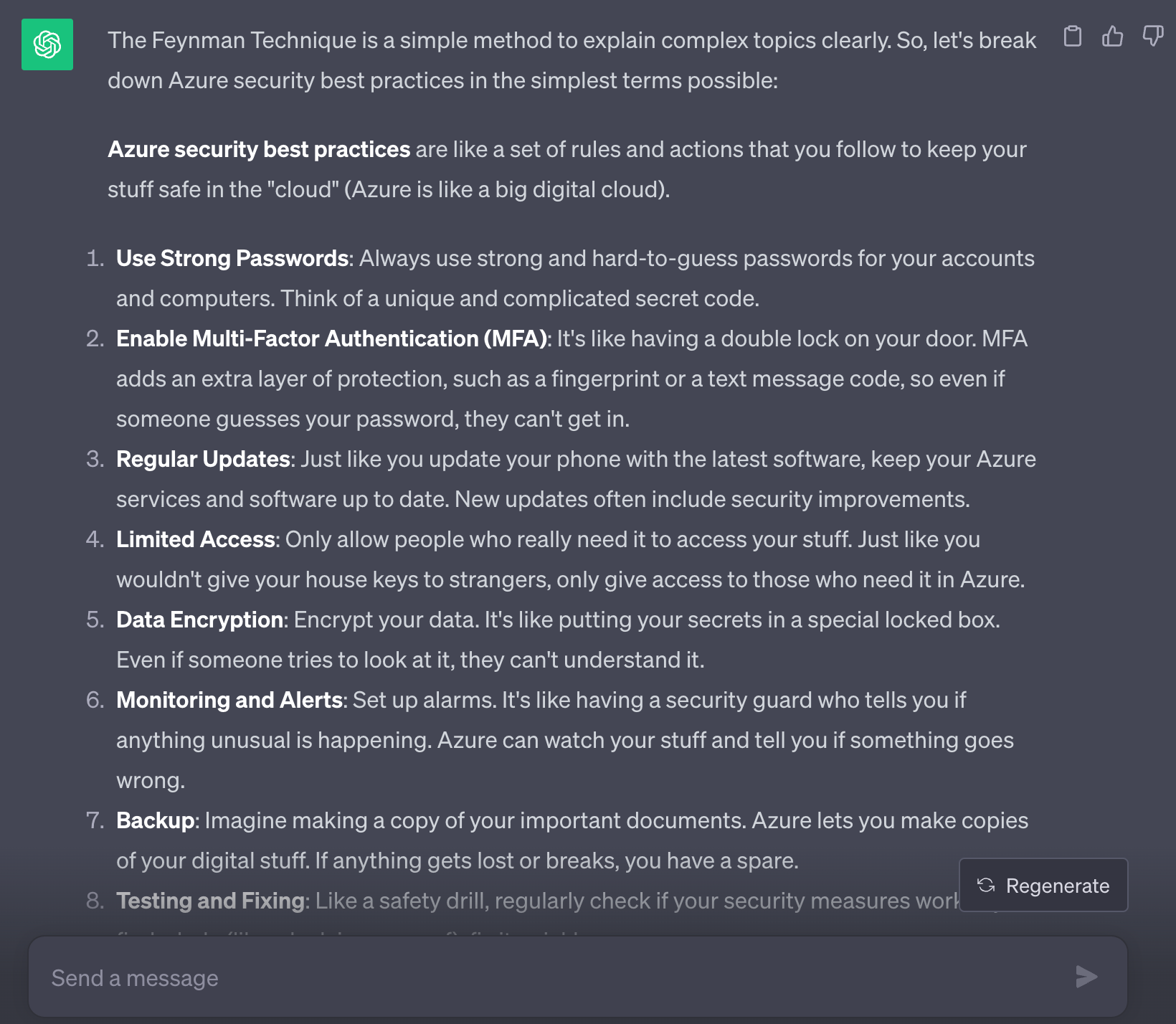
Mental Models and Analogies
Mental models and analogies serve as cognitive shortcuts, helping us grasp intricate concepts by drawing parallels to more familiar or simplified ideas. They act as bridges between the known and the unknown, enabling us to apply existing knowledge to new, complex terrain. Just as a treasure map guides explorers to hidden gems, mental models and analogies guide our understanding. By framing intricate subjects in relatable terms, they not only make learning more accessible but also enhance our ability to remember and apply what we’ve learned.
Use mental models and analogies to help me understand the concept of how to configure Azure Security Center
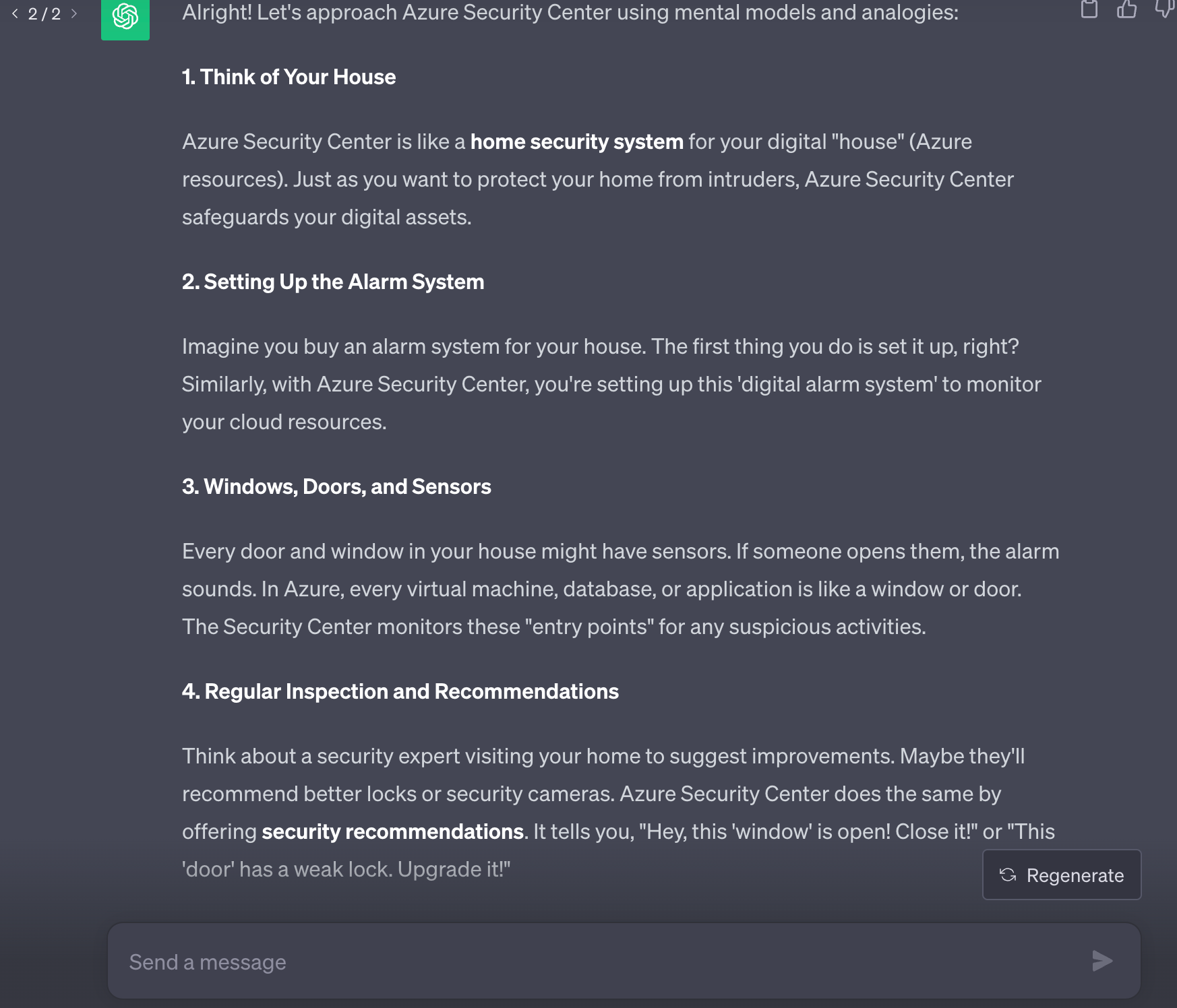
Thought Experiment Exercises
ChatGPT can assist in crafting thought exercises that challenge your comprehension of a topic. These exercises act like a litmus test for your knowledge, either confirming your understanding or highlighting areas where you need to fill in the gaps.
Give me a thought experiment exercise that tests my knowledge of Azure Bastion implementation
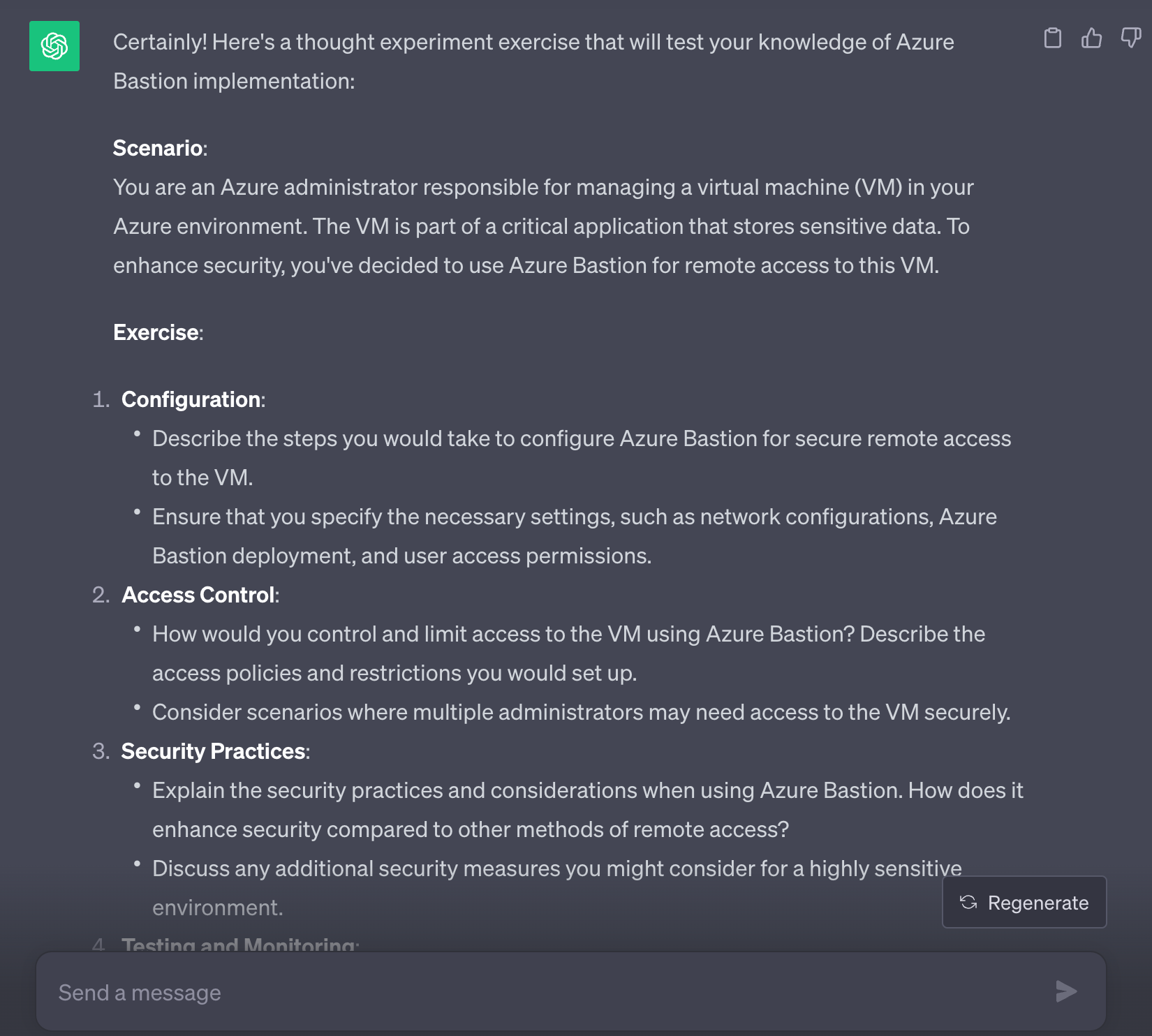
Taking your learning to the next level, you can ask ChatGPT for a step-by-step breakdown of the answer to your exercise. This is like having a personal tutor dissecting the solution, helping you validate your thought process and iron out any wrinkles in your understanding. It’s an invaluable tool for refining your skills and deepening your comprehension.
Walk me through a step by step explanation of the answer to this exercise
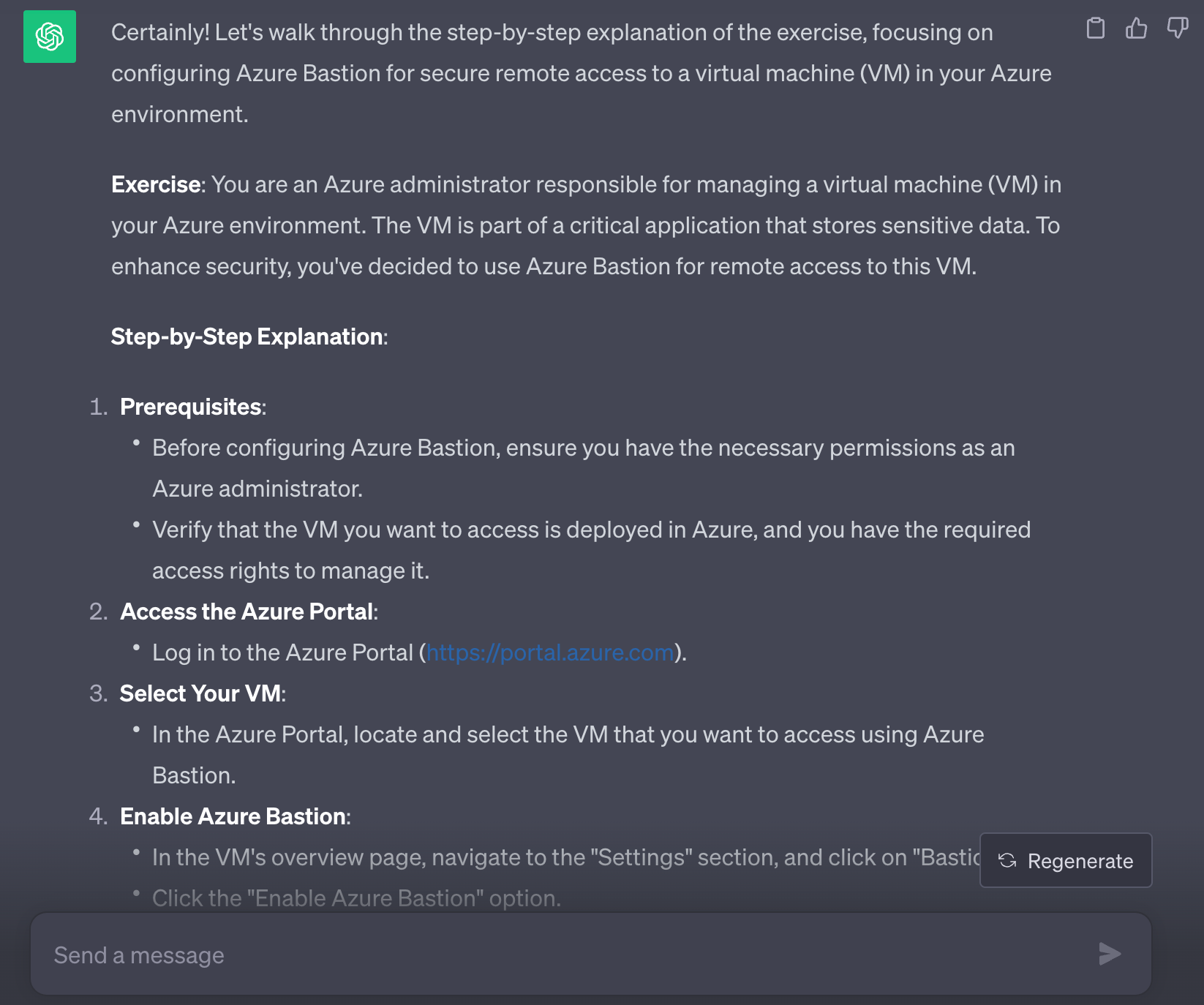
The Socratic Method
Once you’re confident in your understanding of a topic, it’s time to flex those mental muscles with the Socratic Method. It’s like turning into your own inner Socrates, questioning and challenging your own comprehension. By asking probing questions and seeking deeper insights, you can unearth a richer, more nuanced understanding of the subject.
I want you to act as a Socrat and use the Socratic method to help me improve my critical thinking, logic, and reasoning skills. Your task is to ask open-ended questions to the statement I make and after I provide a response, give me constructive feedback to each response before you ask the next question.
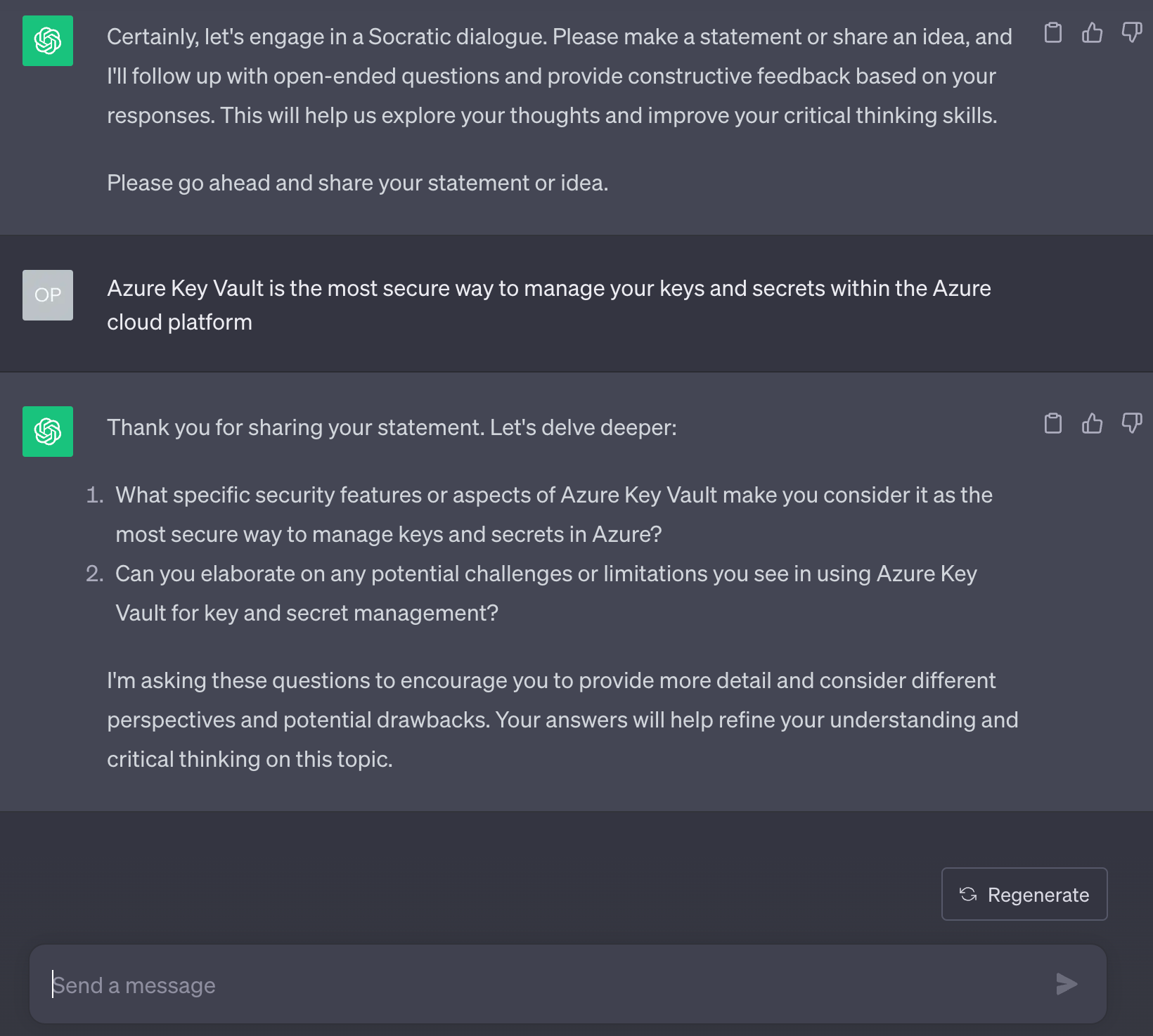
With this technique you share your statement or opinion, and ChatGPT can act as your sparring partner, challenging your assertion. When you respond, ChatGPT provides constructive feedback, encouraging critical thinking and refining your viewpoint. It’s like having a dynamic debate partner, helping you refine and deepen your understanding through thoughtful discussion
Learn On The Go
Once you’ve settled on the topics you’re eager to explore, you can leverage ChatGPT in combination with freely available online resources to craft an engaging audio podcast. This podcast becomes your mobile classroom, perfect for on-the-go learning during activities like workouts or commuting. It’s like having a pocket-sized university lecturer that lets you multitask, so you can soak up knowledge while you’re on the move.
Start by asking ChatGPT to generate a detailed and concise explanation of a topic
Create a detailed and concise summary on the most important things to know about [topic]
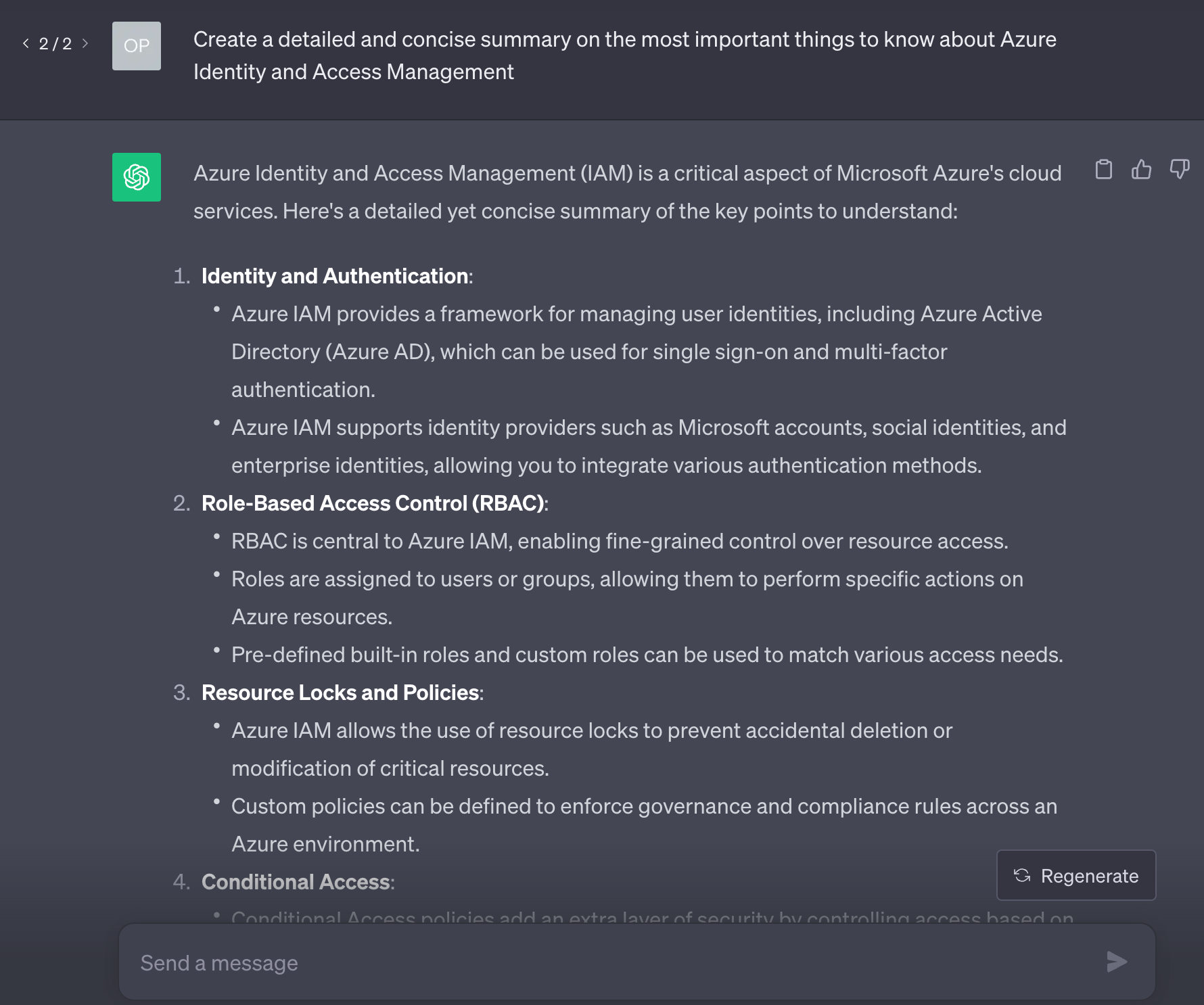
Next, take the entirety of ChatGPT’s response and paste it into the website http://elevenlabs.com. This will transform the text into spoken content, turning your carefully generated explanation into a podcast-ready audio file.
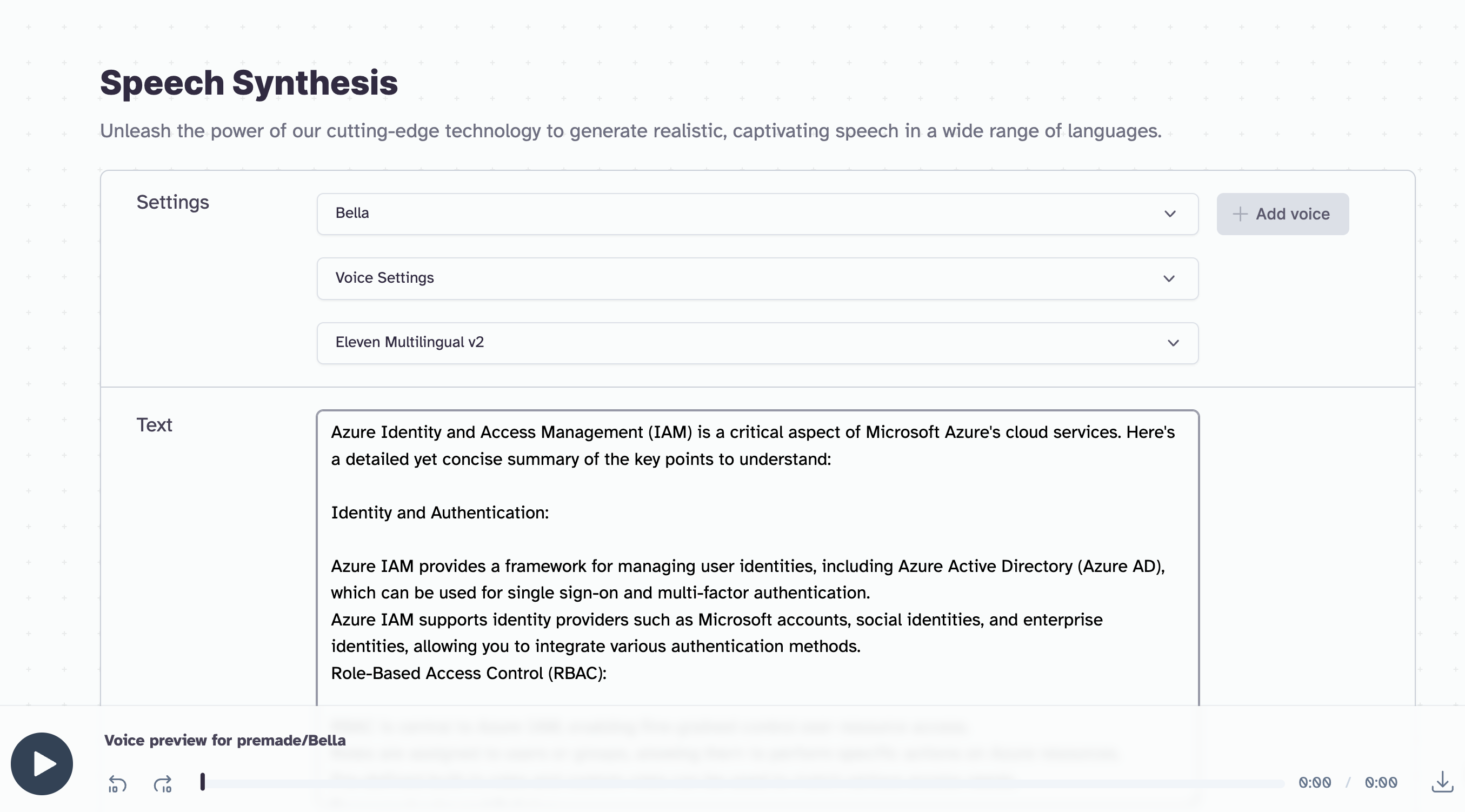
Once you’ve downloaded the audio file, head over to https://anchor.fm, where you can set up a new account and create your own podcast. Upload the audio file as a new episode, and your podcast is ready to roll.
Now, on your trusty streaming device, find your podcast on Spotify. You’re all set to embark on your learning journey at your convenience, whether you’re hitting the gym, stuck in traffic, or just relaxing at home. It’s like having your personal radio station, bringing knowledge straight to your ears.

You can check out the results for your self here: Casey’s Cranium Concepts
Active Recall and Spaced Repetition
Active recall and spaced repetition are like the dynamic duo of effective learning. They work together to help you remember information for a longer time by optimising review intervals and actively engaging with the material. This approach is more efficient than traditional study methods and can help you retain knowledge over the long term.
Active Recall
Active recall is a way of learning where you try to remember information from your brain without looking at your notes or books. It’s like a memory game. Instead of just reading and hoping you remember, you actively test yourself. This helps make your memory stronger, like practicing a game to get better at it. So, instead of passively reviewing, you actively bring the information to mind, which helps you remember it better in the long run.
Using ChatGPT, we can create a list of questions and answers that we can then use for active recall techniques, such as flash cards.
Topic: Azure Network Security
Create a two column spreadsheet with a total of 20 questions and their corresponding answers to the topic above.
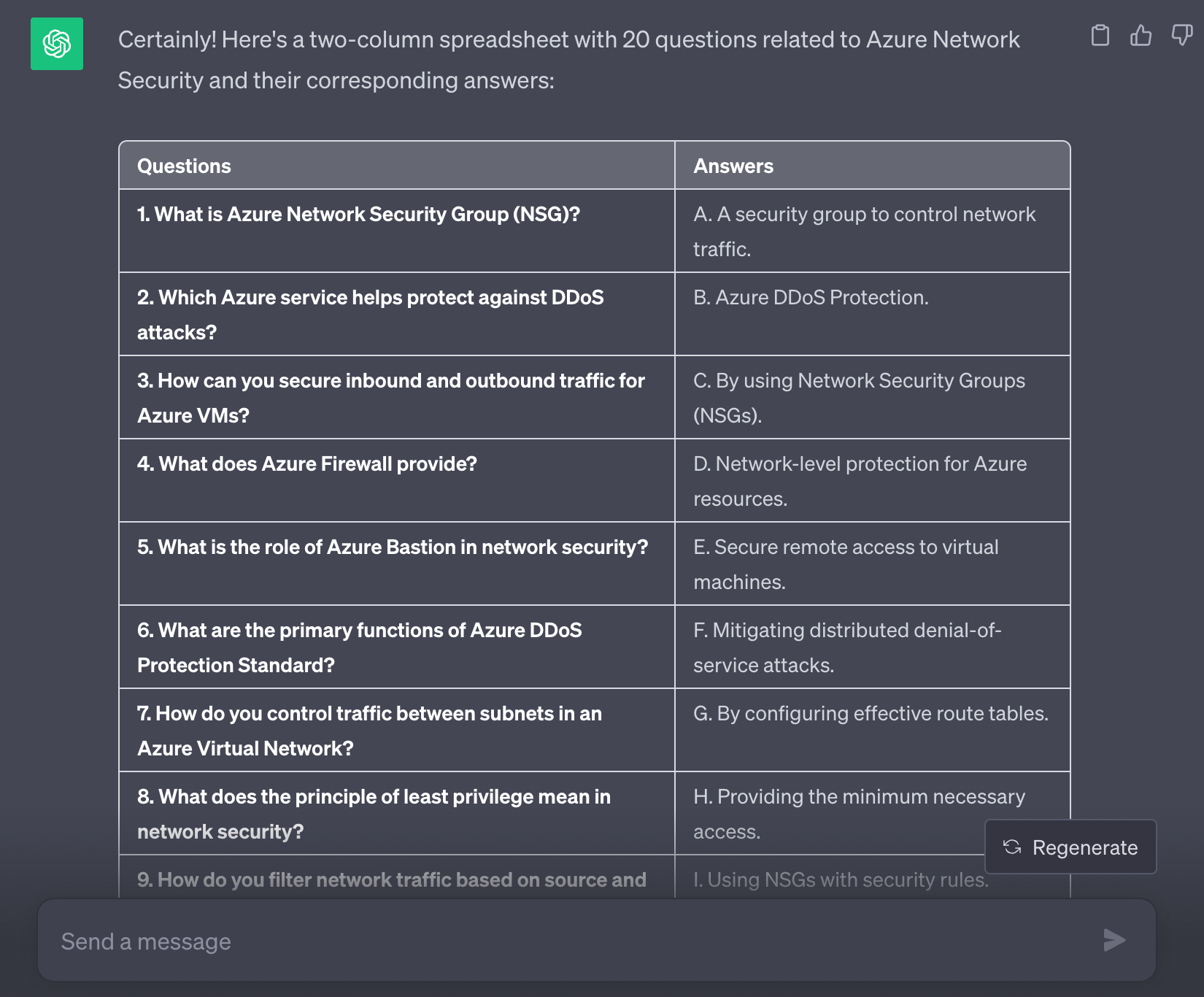
Spaced Repetition
Spaced repetition is an evidence based powerful learning strategy that aligns with the natural forgetting curve. It leverages the curve by scheduling reviews when you’re most likely to forget, which strengthens your memory over time, ultimately making the information stick in your long-term memory.
Reviewing material at strategic times helps you to remember things for a long time. This way, you don’t forget what you’ve learned, and the knowledge becomes more permanent.
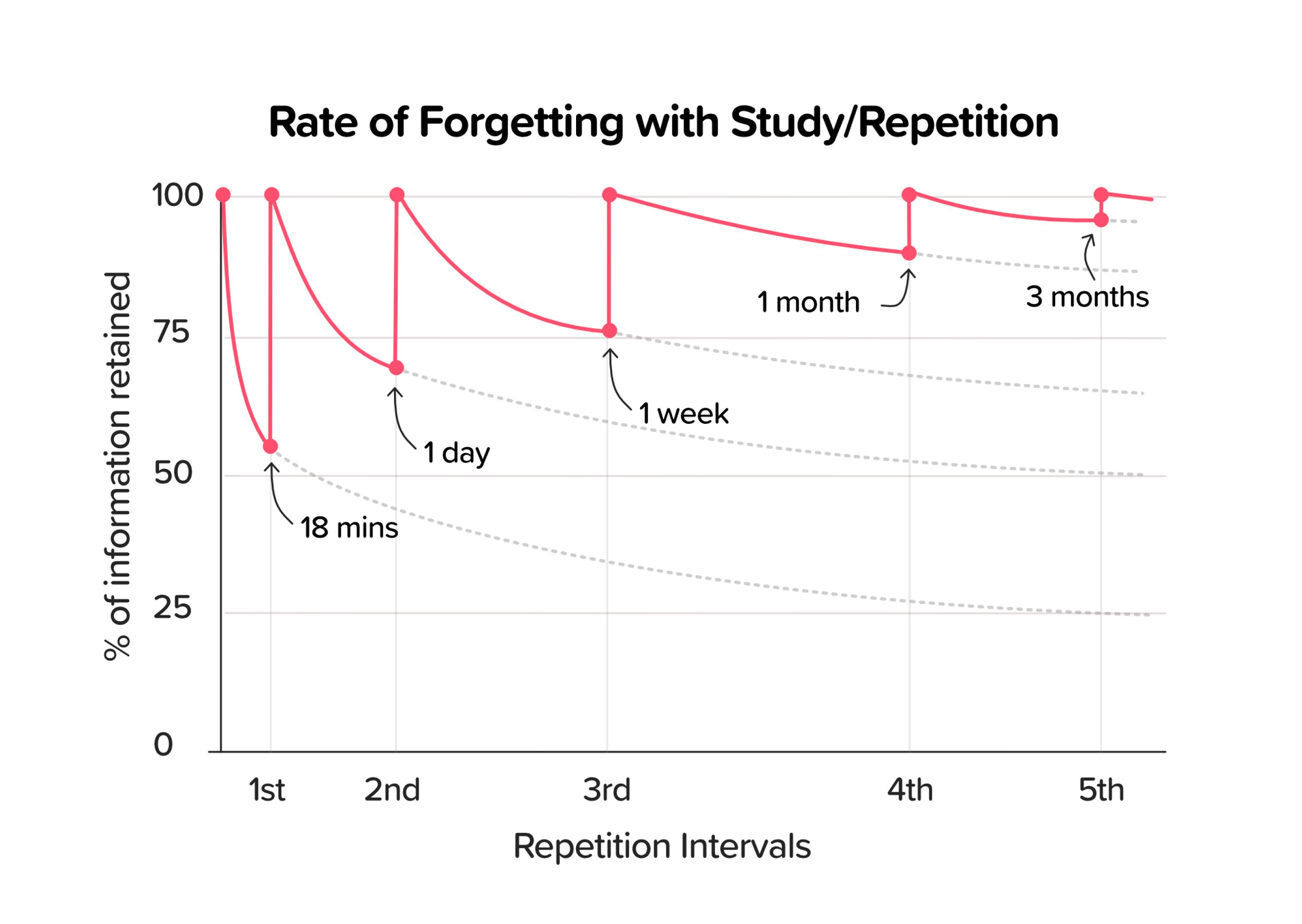
Create yourself a review schedule (you can use ChatGPT for this too), and when it comes time to review, use ChatGPT to generate your questions.
Topic: Identity and Access Management
Create multiple choice questions that test my knowledge of this topic and are similar to what I might expect to see on the AZ-500 exam. Each question should have 4 incorrect distractor answers, and 1 correct one. Answers should be labelled A to E. When I respond with an answer, I want you to tell me whether it is correct, and provide an explanation of the answer. Then ask me another question.
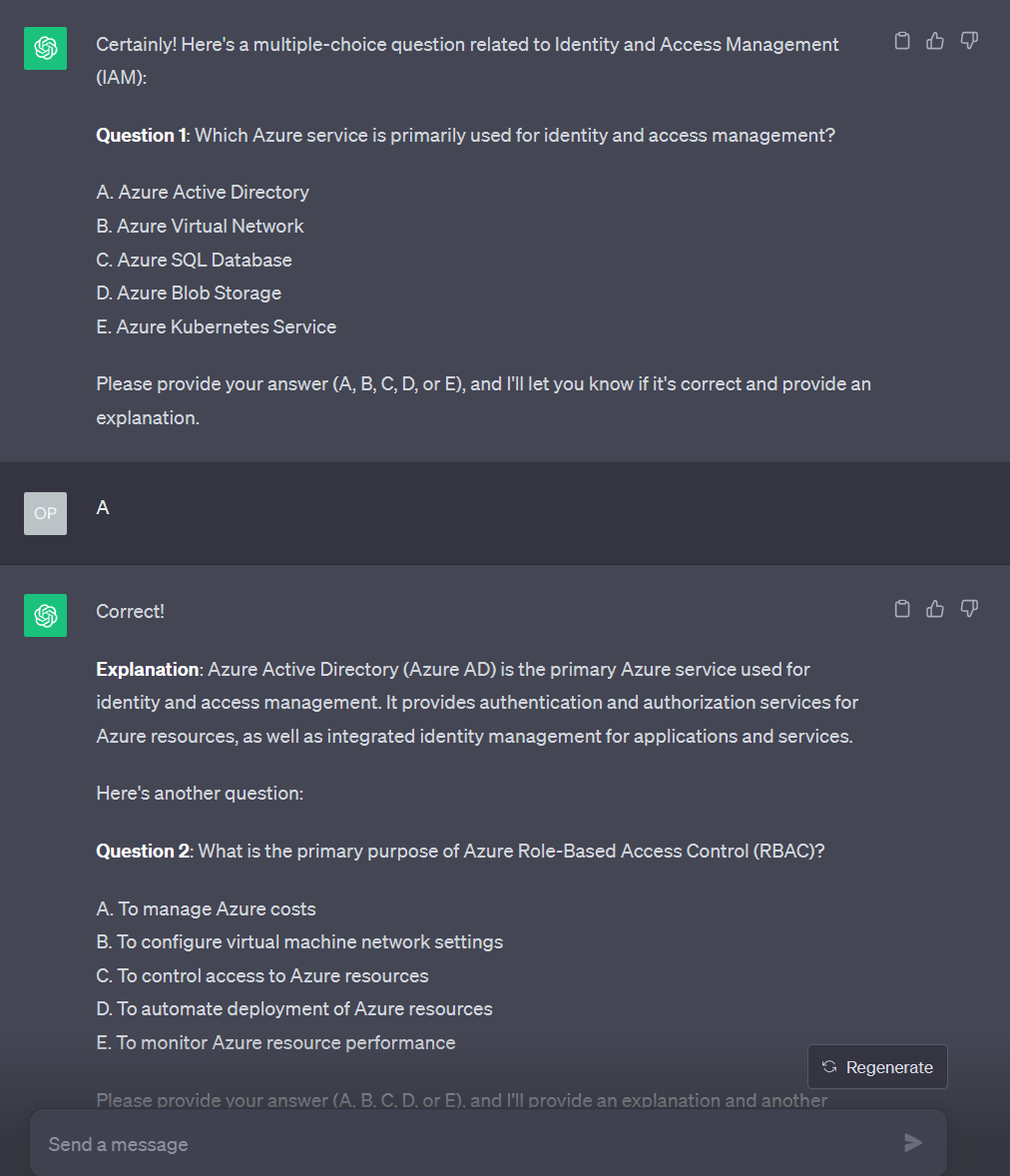
To make spaced repetition work best, you should test your overall knowledge regularly and review the things you’re not so good at more often.
For instance, if you plan to spend an hour every night answering 50 practice questions, in your first session, cover questions from all the topics. Keep track of the topics where you made mistakes. In your next session, make sure that at least half of the questions you answer are about those specific topics you got wrong. This forces to you engage more deeply in areas where your knowledge might be a little light, helping you remember better.
Conclusion
In this blog post I’ve shown you that ChatGPT is more than just a chatbot; it can be a tool for personalized learning. By combining proven learning techniques and structuring the output in creative and engaging ways, you have the means to become your own best teacher. This approach allows you to master even the most complex subjects, all tailored to your preferred learning style, and accessible at any time and place that suits your convenience.
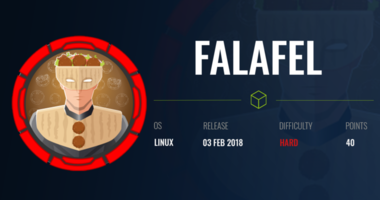
Comments